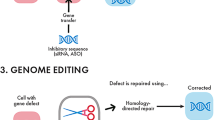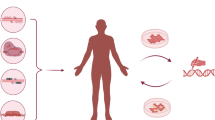Summary
Transfectants obtained by mouse DNA-mediated gene transfer in Fanconi anemia (FA) primary fibroblasts from the genetic complementation groups A and B were examined for the frequencies of chromosomal aberrations and cytotoxicity following treatments by cross-linking agents. Cells from group A (FA 150), which is the most sensitive to such agents, are partially corrected for both the chromosomal and cellular hypersensitivity to 8-methoxypsoralen photoaddition. In contrast, after treatment with mitomycin C (MMC), only the chromosomal sensitivity is re-established to a near normal level. The opposite is true for FA group B cells (FA 145), i.e. cell survival to MMC is partially corrected, whereas the frequency of MMC-induced chromosomal aberration remains close to that of the untransfected cells. The partial phenotypic correction of the two end points examined is interpreted as indicating either a gene dosage effect or the necessity of introducing more than one gene type in order to achieve complete recovery of a normal phenotype. The phenotypic dissociation between the clastogenic and cellular hypersensitivity to crosslinking agents may offer the opportunity of isolating separately the responsible gene(s) by conventional rescue techniques.
Similar content being viewed by others
References
Arrand JE, Bone NM, Johnson RT (1989) Molecular cloning and characterization of a mammalian excision repair gene that partially restores UV resistance to xeroderma pigmentosum complementation group D cells. Proc Natl Acad Sci USA 86:6997–7001
Auerbach AD, Wolman SR (1976) Susceptibility of Fanconi's anemia fibroblasts to chromosome damage by carcinogens. Nature 261:494–496
Averbeck D, Papadopoulo D, Moustacchi E (1988) Repair of 4,5′,8-trimethylpsoralen plus light induced DNA damage in normal and Fanconi's anemia cell lines. Cancer Res 48:2015–2020
Berger R, Bernheim A, Coniat ML, Vecchione D, Schaison G (1980) Nitrogen mustard-induced chromosome breakage. A tool to Fanconi's anemia diagnosis. Cancer Genet Cytogenet 2:269–274
Berman JW, Basch RS, Pellicer A (1984) Gene transfer in lymphoid cells: expression of the Thy-1. 2 antigen by Thy-1. 1 BW 5147 lymphoma cells transfected with unfractionated cellular DNA. Proc Natl Acad Sci USA 81:7176–7179
Buchwald M, Clarke JC, Duckworth-Rysiecki G (1987) Studies of gene transfer and reversion to mitomycin C resistance in Fanconi anemia cells. Mutat Res 184:153–159
Cleaver JE (1974) Repair processes for photochemical damage in mammalian cells. In: Lett JL, Adler H, Zelle M (eds) Advances in radiation biology, vol 4. Academic Press, New York, pp 1–75
Countryman PI, Heddle J (1976) The production of micronuclei from chromosome aberrations in irradiated cultures of human lymphocytes. Mutat Res 41:321–332
Diatloff-Zito C, Papadopoulo D, Averbeck D, Moustacchi E (1986) Abnormal response to DNA crosslinking agents of Fancord anemia fibroblasts can be corrected by transfection with normal human DNA. Proc Natl Acad Sci USA 83:7034–7038
Digweed M, Sperling K (1989) Identification of a Hela mRNA fraction which can correct the DNA repair defect in Fanconi anemia fibroblasts. Mutat Res 218:171–177
Digweed M, Zakrzewski-Lüdcke S, Sperling K (1988) Fanconi's anemia: correction of genetic complementation group with psoralen/UVA response. Hum Genet 78:51–54
Duckworth-Rysiecki G, Cornich K, Clarke CA, Buchwald M (1985) Identification of two complementation groups in Fanconi's anemia. Somat Cell Mol Genet 11:35–43
Dutrillaux B, Couturier J (1981) La pratique de l'analyse chromosomique. Masson, Paris
Elmore E, Swift M (1976) Growth of cultured cells from patients with Fanconi anemia. J Cell Physiol 87:229–234
Fanconi G (1967) Familial constitutional panmyelopathy, Fanconi's anemia (FA). I. Clinical aspects. Semin Hematol 4:233–240
Feinberg AP, Vogelstein B (1983) A technique for radiolabeling DNA restriction endonuclease fragments to high specific activity. Anal Biochem 132:6–13
Fenech M, Morley AA (1985) Measurement of micronuclei in human lymphocytes. Mutat Res 149:29–36
Gursurinder PK, Athwal RS (1989) Complementation of a DNA repair defect in xeroderma pigmentosum cells by transfer of human chromosome 9. Proc Natl Acad Sci USA 86:8872–8876
Heddle JA, Lue CB, Saunders EF, Benz RD (1978) Sensitivity to five mutagens in Fanconi's anemia as measured by the micronucleus method. Cancer Res 38:2983–2988
ISCN (1985) An international system for human cytogenetic nomenclature. Harnden DG, Klinger HP (eds) Published in collaboration with Cytogenet Cell Genet. Karger, Basel
Ishida R, Buchwald M (1982) Susceptibility of Fanconi's anemia lymphoblasts to DNA-cross-linking and alkylating agents. Cancer Res 42:4000–4006
Kai R, Ohtsubo M, Sekiguchi M, Nishimoto T (1986) Molecular cloning of a human gene that regulates chromosome condensation and is essential for cell proliferation. Mol Cell Biol 6:2027–2032
Kapp LN, Painter RB (1989) Stable radioresistance in ataxiatelangiectasia cells containing DNA from normal human cells. Int J Radiat Biol 56:667–675
Lambert WC, Lambert MW (1985) Co-recessive inheritance: a model for DNA repair, genetic disease and carcinogenesis. Mutat Res 145:227–234
Latt SA, Stetten E, Juergens LA, Buchanan GR, Gerald PS (1975) Induction by alkylating agents of sister chromatid exchanges and chromatid breaks in Fanconi's anemia. Proc Natl Acad Sci USA 72:4066–4070
Lin PF, Zhao SY, Ruddle FH (1983) Genomic cloning and preliminary characterization of the human thymidine kinase gene. Proc Natl Acad Sci USA 80:6528–6532
Moustacchi E, Diatloff-Zito C (1985) DNA semi-conservative synthesis in normal and Fanconi anemia fibroblasts following treatment with 8-methoxypsoralen and near ultraviolet light or with X-rays. Hum Genet 70:236–242
Moustacchi E, Papadopoulo D, Diatloff-Zito C, Buchwald M (1987) Two complementation groups of Fanconi's anemia differ in their phenotypic response to a DNA cross-linking treatment. Hum Genet 75:45–47
Nagasawa H, Little JB (1983) Suppression of cytotoxic effect of mitomycin-C by superoxide dismutase in Fanconi's anemia and dyskeratosis congenita fibroblasts. Carcinogenesis 4:795–798
Papadopoulo D, Averbeck D, Moustacchi E (1987) The fate of 8-methoxypsoralen-photoinduced DNA interstrand crosslinks in Fanconi's anemia cells of defined genetic complementation groups. Mutat Res 184:271–280
Papadopoulo D, Porfirio B, Moustacchi (1990) Mutagenic response of Fanconi's anemia cells from a defined complementation group after treatment with photoactivated bifunctional psoralens. Cancer Res 50:3289–3294
Poll EHA, Arwert F, Joenje H, Erikson AW (1982) Cytogenetic toxicity of antitumor platinum compounds in Fanconi's anemia. Hum Genet 61:228–230
Rosselli F, Moustacchi E (1990) Cocultivation of Fanconi's anemia cells and of mouse lymphoma mutants leads to complementation of chromosomal hypersensitivity to DNA cross-linking agents. Hum Genet 84:517–521
Rousset S, Nocentini S, Revet B, Moustacchi E (1990) Removal of psoralen photo-induced DNA cross-links in normal and Fanconi's anemia fibroblasts: a molecular analysis by electron microscopy. Cancer Res 50:2443–2448
Royer-Pokora B, Haseltine N (1984) Isolation of UV resistant revertants from xeroderma pigmentosum complementation group A cell line. Nature 311:390–392
Sasaki MS (1978) Fanconi's anemia: a condition possibly associated with a defective DNA repair. In: Hanawalt PC, Friedberg EC, Fox CF (eds) DNA repair mechanisms. Academic Press, New York, pp 675–684
Sasaki MS, Tonomura A (1973) A high susceptibility of Fanconi's anemia to chromosome breakage by DNA-cross-linking agents. Cancer Res 33:1829–1836
Saxon PJ, Schultz RA, Stanbridge EJ, Friedberg EC (1989) Human chromosome 15 confers partial complementation of phenotypes to xeroderma pigmentosum group F cells. Am J Hum Genet 44:474–485
Schroeder TM, Tilgen D, Krüger J, Vogel F (1976) Formal genetics of Fanconi's anemia. Hum Genet 32:257–288
Schroeder-Kurth TM, Auerbach AD, Obe G (eds) (1989) Fanconi anemia. Clinical, cytogenetic and experimental aspects. Springer, Berlin Heidelberg New York
Schultz RA, Barbis DP, Friedberg EC (1985) Studies on gene transfer and reversion to UV resistance in xeroderma pigmentosum cells. Somat Cell Mol Genet 11:617–624
Shaham M, Adler B, Ganguly S, Chaganti RSK (1987) Transfection of normal human and Chinese hamster DNA corrects diepoxybutane-induced chromosomal hypersensitivity of Fanconi anemia fibroblasts. Proc Natl Acad Sci USA 84:5853–5857
Southern EM (1975) Detection of specific sequences among DNA fragments separated by gel electrophoresis. Mol Biol 98:503–517
Tanaka K, Satokata I, Ogita Z, Uchida T, Okada Y (1989) Molecular cloning of a mouse DNA repair gene that complements the defect of group A xeroderma pigmentosum. Proc Natl Acad Sci USA 86:5512–5516
Thompson LH, Bachinski LL, Stallings RL, Dolf G, Weber CA, Westerveld A, Siciliano MJ (1989) Complementation of repair gene mutations on the hemizygous chromosome 9 in CHO: a third repair gene on human chromosome 19. Genomic 5:670–679
Tomasz M, Chowdary D, Lipman R, Shimotakahara S, Veiro D, Walker V, Verdine GL (1986) Reaction of DNA with chemically or enzymatically activated mitomycin C: isolation and structure of the major covalent adduct. Proc Natl Acad Sci USA 83:6702–6706
Weber CA, Salazar EP, Stewart SA, Thompson LH (1988) Molecular cloning and biological characterization of a human gene, ERCC2, that corrects the nucleotide excision repair defect in CHO UV5 cells. Mol Cell Biol 8:1137–1146
Weksberg R, Buchwald M, Sargent P, Siminovitch L (1979) Specific cellular defects in patients with Fanconi's anemia. J Cell Physiol 101:311–324
Westerveld A, Hoeijmakers JHJ, Van Duin M, De Wit J, Odijk H, Pastink A, Wood RD, Bootsma D (1984) Molecular cloning of a human DNA repair gene. Nature 310:425–429
Zdzienicka MZ, Van der Schans GP, Westerveld A, Van Zeeland AA, Simons JWIM (1988) Phenotypic heterogeneity within the first complementation group of UV-sensitive mutants of Chinese hamster cell lines. Mutat Res 193:31–41
Author information
Authors and Affiliations
Rights and permissions
About this article
Cite this article
Diatloff-Zito, C., Rosselli, F., Heddle, J. et al. Partial complementation of the Fanconi anemia defect upon transfection by heterologous DNA. Hum Genet 86, 151–161 (1990). https://doi.org/10.1007/BF00197697
Received:
Revised:
Issue Date:
DOI: https://doi.org/10.1007/BF00197697




